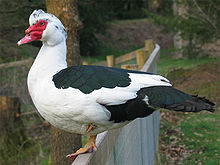Musk duck
| Musk duck | ||||||||||||
|---|---|---|---|---|---|---|---|---|---|---|---|---|

Musk duck ( Cairina moschata ), park in São Paulo , Brazil |
||||||||||||
| Systematics | ||||||||||||
|
||||||||||||
| Scientific name | ||||||||||||
| Cairina moschata | ||||||||||||
| ( Linnaeus , 1758) |
The musk duck ( Cairina moschata ) is a large species of duck from the group of real ducks that is native to South America. It is one of the two representatives of the genus Cairina and the wild form of the domesticated wart duck.
Appearance
The characteristic feature is the featherless face with the wart-like formation at the base of the beak, which is clearly evident in the drake. On the head there is a low, adjustable spring hood.
While the wild musk duck is black with a colored shimmer and sometimes white wing-coverts, there are many different colors for domestic animals. The tail is broad and flat.
Way of life
Musk ducks inhabit wooded areas with lakes or rivers. They feed on plants that they ingest on land or in shallow water.
The ducks can breed up to three times a year. The clutch consists of 8 to 21 eggs, which are usually laid in a tree cavity. The incubation period is up to 35 days. The hatched chicks, like all ducks, flee the nest. Immediately after hatching, they leave the nest with a dive into the depths.
Keeping and breeding
Origins
The musk duck was kept by Indians for centuries before 1492. In 1514, Spanish ships brought this species of duck to Europe for the first time. From there it spread rapidly to Africa, Madagascar and tropical Asia. Carl von Linné, for example, used a description from India to classify this species. The generic name indicates the city of Cairo.
The wild form was first described scientifically in 1902.
The wart duck as a pet form of the musk duck
The wart duck, also known as the mute, flying, Turkish or Barbarie duck (from French Canard de Barbarie ) is the domestic form of the musk duck.
Warty ducks are available in different colors. The plumage of the animals ranges from light tones (white, gray) to dark (blue, brown, black or wild-colored). In addition to the monochrome wart ducks, there are also pied ducks (e.g. black and white, brown and white, blue and white). Because of this blaze of color, wart ducks are not only kept for economic purposes, but also as ornamental birds.
The sexual dimorphism is more pronounced in the wart duck than in the wild form: four-month females weigh about 2 kg, four-month drakes, on the other hand, weigh 3 to 4 kg; adult animals reach body weights of up to 5 (females) or 7 kg (drakes). The wart duck owes its name to a multi-part hump at the base of the beak.
As " Muscovy duck " next to the domesticated Muscovy duck and intersections with the Peking duck offered so-called " Mularden " (from French Mulard ), considered economically but can only be used as fattening animals as these hybrids are usually infertile.
literature
- Janet Kear (Ed.): Ducks, Geese and Swans. Oxford University Press, 2005, ISBN 0198546459 .
- Hartmut Kolbe: The world's ducks. Ulmer Verlag, 1999, ISBN 3-8001-7442-1 .
Individual evidence
- ↑ Art brood - tips and experiences of the special association of duck breeders. In: Special Association of Duck Breeders in Germany from 1895 eV Accessed on June 21, 2020 (German).
- ↑ Kolbe, p. 173
Web links
- Cairina moschata in the endangered Red List species the IUCN 2008. Posted by: BirdLife International, 2008. Accessed January 31 of 2009.
- Videos, photos and sound recordings of Cairina moschata in the Internet Bird Collection
- Description and breed standard of wart duck, special association of duck breeders in Germany from 1895 eV ., Enten-sv.de
- Musk duck feathers




